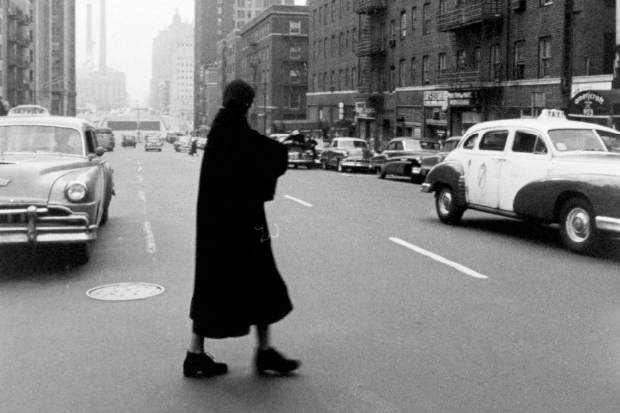Like a lot of people, Olivia Laing came to New York to join a lover. Like a lot of people, she soon became unjoined. She stopped eating and drifted, moved from sublet to sublet, wandered the streets in a desperate daze. She craved intimacy and shied away from it, was painfully self-conscious but also anxious that she was in danger of vanishing. What does loneliness feel like? It feels, she says, ‘like being hungry when everyone around you is readying for a feast. It feels shameful and alarming, and over time these feelings radiate outwards, making the lonely person increasingly isolated, increasingly estranged.’
The Lonely City is memoir, art criticism and a portrait of the Big Apple seen through the eyes of an accidental flâneuse. Laing, who is careful to distinguish between being alone and being lonely, is sensitive to pain. She mentions that after her mother came out of the closet in the 1980s they were driven out of the coastal village where she’d grown up. Her mother’s partner was an alcoholic, and Laing herself dropped out of college and lived for some time in junkie-filled squats. There is a way in which New York, whose Statue of Liberty sports Emma Lazarus’s words, ‘Give me your tired, your poor, your huddled masses yearning to breathe free’, is her natural home.
It’s in the lives and work of artists, many of them queer, many of them associated with downtown New York — David Wojnarowicz, Peter Hujar, Klaus Nomi, Nan Goldin — that she finds companionship, examples of how to ‘resist loneliness, to make a joyous art of difference’. Individuals, often seen as cool, edgy, fearless transgressors, are portrayed as scratched, nervous humans. Her Andy Warhol is Andrej Warhola, the bullied child of Slovakian immigrants, disfigured by acne, self-conscious about his speech impediment. Capote called him ‘the most friendless person I’d ever met in my life’; his nickname ‘Drella’ was from Cinderella, the girl left behind while everyone else was at the ball. Hardly surprising, Laing suggests, if he used machines such as the Polaroid or 16mm Bolex camera to keep the world at bay — to the extent that he called his tape recorder ‘my wife’.
She writes sympathetically about him, his would-be assassin Valerie Solanas (founder of Scum — the Society for Cutting Up Men), Greta Garbo, Edward Hopper. And also about Henry Darger, known today as an extraordinary and extraordinarily creepy outsider artist responsible for The Story of the Vivian Girls, a mythological war tale over 15,000 pages long and full of beautiful, horrific images of naked young girls being choked, tortured and hanged. Darger was born to a crippled father and a mother who died when he was four, sent to an asylum for feeble-minded children, and though he ran away, spent most of his life working as a janitor and living alone in a boarding house. Laing is fascinated by the way he deployed found images and tracing techniques to create visual abundance, and fascinating in her attention to ‘the gaze of agony, the gaze of empathy, and the gaze of disassociation’ she discerns in his imagery.
It’s sometimes claimed, mostly by idiots, that the internet helps combat loneliness. Pack up your troubles and get connected, interact, join the network! Laing, who is by no means a technophobe (she describes her laptop as ‘my cathected silver lover’), evokes what she calls the ‘isolation and data dependency’ of the digital realm:
This descending scroll from mostly strangers, institutions, friends, this ephemeral community in which I was a disembodied and inconstant presence … news of a death, protest picture, art opening, joke about Derrida, refugees in the forests of Macedonia, hashtag shame, hashtag lazy.
It may seem odd, but this book, with its 50 shades of blue, with many passages as bruised and gorgeous as those in the fictions of writers such as Jean Rhys and Sam Selvon — imbues New York with a perverse romance. At one point Laing finds herself
clinging hopelessly to the city itself: the repeating tapestry of psychics and bodegas, the bump and grind of traffic, the live lobsters on the corner of Ninth Avenue, the steam drifting up from beneath the streets.
It makes me, who actually lives there, feel as if I’ve had my eyes and ears closed to it for far too long. Perhaps I’m dead? Laing says: ‘Loneliness, longing, does not mean one has failed, but simply that one is alive.’
The beaten-up, character-rich East Village in which she and many of her beloved artists lived has increasingly been taken over by mani-pedi salons, frozen-yoghurt stores, shrines to emollience. Laing, eschewing narcissism and navel-gazing to the end, concludes with a warning about not only urban gentrification but a gentrification of the emotions:
Amidst the glossiness of late capitalism, we are fed the notion that all difficult feelings — depression, anxiety, loneliness, rage — are simply a consequence of unsettled chemistry, a problem to be fixed, rather than a response to structural injustice.






Comments